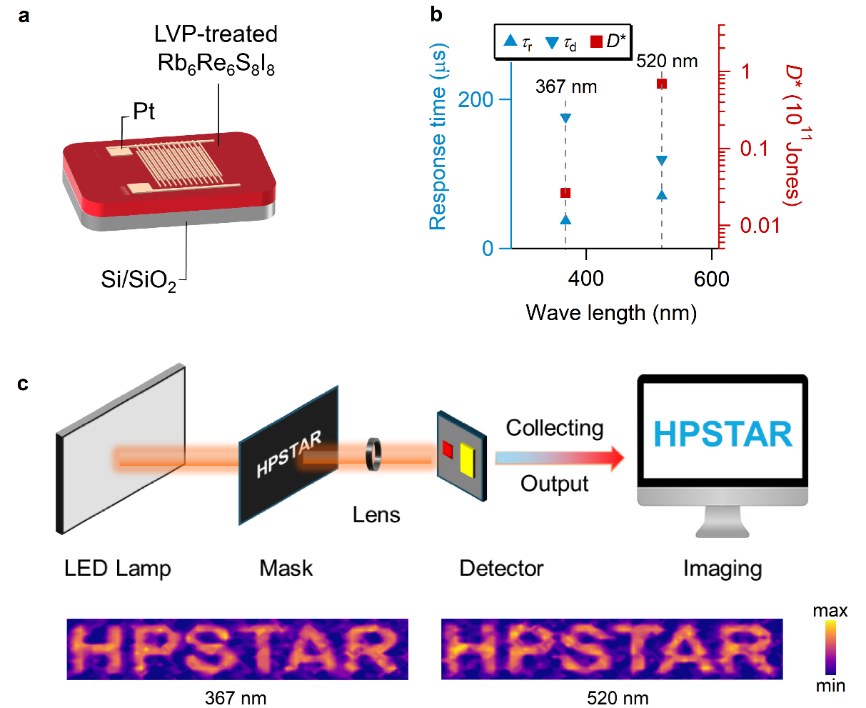
A groundbreaking study led by Drs. Lingping Kong and Gang Liu from HPSTAR has unveiled a significant advancement in pressure engineering, challenging conventional limitations in device fabrication. Their research, published in Nature Communications under the title "Retention of high-pressure solution-processable metastable phase to ambience via differential sublattice rigidity for broadband photodetectors," demonstrates the irreversible structural and property evolution of the metastable sulfur halide compound Rb6Re6S8I8 under high pressure. By leveraging this discovery, the team successfully fabricated high-performance photoelectric response devices using a large-volume press, marking a pivotal shift in the field of pressure engineering.
Historically, high-pressure techniques have been instrumental in uncovering extraordinary material properties. However, retaining these properties after decompression to ambient conditions has posed a significant challenge, often resulting in the degradation or loss of pressure-regulated characteristics. The researchers addressed this limitation by exploiting the differential rigidity between sublattices in the mixed-anion chalcohalide Rb6Re6S8I8. Specifically, they utilized the soft and plastic nature of the [Rb6I2]4+ framework and the hard and elastic nature of the [Re6S8I6]4− cluster to induce pressure-driven amorphization of the framework while preserving the crystalline integrity of the cluster. This selective amorphization allowed the material to retain its high-pressure properties even after decompression, a critical breakthrough for practical device applications.
The team employed advanced high-pressure experimental techniques, including synchrotron-based X-ray diffraction, Raman spectroscopy, and X-ray absorption spectroscopy, to elucidate the underlying mechanisms of this unique behavior. Their findings revealed that the [Re6S8I6]4− clusters remained structurally intact under high pressure, while the [Rb6I2]4+ framework underwent significant changes, resulting in long-range disorder. This decoupling of sublattices was further validated by pressure-dependent photoluminescence and photocurrent measurements, which highlighted the emergence of novel photoelectric properties under compression—properties that persisted at ambient pressure.
To demonstrate the practical applicability of their discovery, the researchers synthesized decompressed Rb6Re6S8I8 using a large-volume press. The solution-processable nature of the decompressed material enabled the fabrication of Schottky-type photodetector devices, which exhibited exceptional performance metrics, including a specific detectivity of ~1011 Jones and a response time of ~102 μs. Molecular dynamics simulations further revealed that the large deformability of the [Rb6I2]4+ framework played a crucial role in stabilizing the metastable phase and enabling the observed optoelectronic properties.
This groundbreaking research challenges the long-held assumption that pressure engineering has limited practical utility in device fabrication due to the loss of material properties upon decompression. By harnessing the concept of differential sublattice rigidity, the team has pioneered a novel strategy to retain high-pressure-induced properties at ambient conditions, paving the way for the application of pressure-treated materials in advanced optoelectronics. The findings not only demonstrate the feasibility of scalable device fabrication using decompressed materials but also establish a framework for understanding and optimizing the high-pressure behavior of mixed-anion compounds. This work holds significant promise for the development of next-generation functional materials with tailored optoelectronic properties, potentially impacting a broad spectrum of technological applications.

Caption: (a) Schematic illustration of a Schottky-type thin-film Rb6Re6S8I8 photodetector device. (b) Response time and specific detectivity (D*) under 367 nm and 520 nm illumination. Here, τr and τd represent the rise and decay response times, respectively. (c) Schematic diagram of the ultraviolet and visible imaging device. Photocurrent mappings were obtained by irradiating the device with the “HPSTAR” logo mask using 367 nm ultraviolet and 520 nm visible lasers. The color scale, labeled “Max” and “Min,” indicates the relative magnitudes of photocurrent activity.
近日,北京高压科学研究中心的刘罡研究员与孔令平研究员带领的研究团队在压力工程领域取得了突破性进展。他们揭示了亚稳态硫卤化物Rb6Re6S8I8在高压下结构和物性的不可逆演变机制。基于这一发现,团队利用大腔体压机实现了样品的规模化压力处理,并凭借其优异的溶液加工特性成功制备出高性能光电响应器件。这项研究颠覆了传统观点 “压力工程难以应用于器件制造”,为利用极端条件设计和制备理想光电材料提供了重要指导。相关成果以“Retention of high-pressure solution-processable metastable phase to ambience via differential sublattice rigidity for broadband photodetectors”为题发表在Nature Communications上。